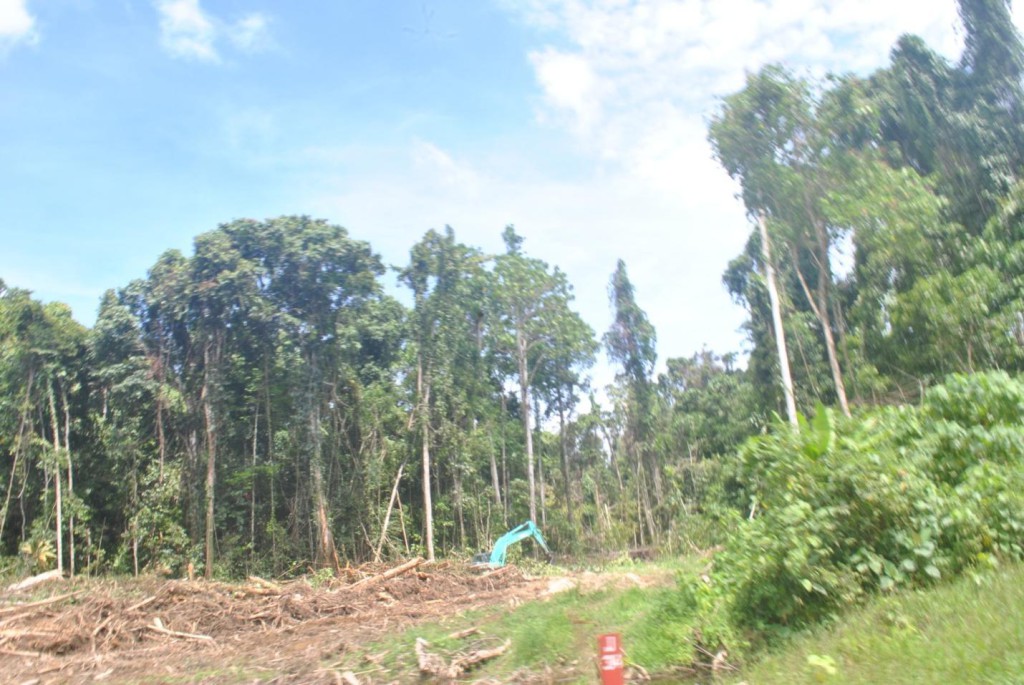(Apologies for the delay in Posting to the site (all news still is being delivered to journalists direct as it breaks). WPM has been under severe security threat from Indonesian agents in Papua and Australia, associated with the arrests of French journalists).
Reports from our network partners at AwasMifee
On 19th August, Martinus Yohame in his role as the chair of the Sorong Branch of the West Papua National Committee (KNPB) held a press conference, explaining his organisation’s opposition to the Indonesian President’s visit to the area to open the Sail Raja Ampat event aimed at promoting tourism to Papua. He also raised the issue of illegal logging. The next day he disappeared.
As friends and colleagues spent the subsequent days searching for him, President Susilo Bambang Yudhoyono opened the sailing regatta, where he once again promised extra funds to develop infrastructure for infrastructure in Papua, and also inaugurated a statue of Jesus Christ on Marsinam Island near Manokwari.
Then on the 26th, a fisherman found the body of Martinus Yohame floating by the shore in at Nana Island, near Sorong. He had been shot in the chest, his face smashed up, and with another wound in his stomach. He had been placed in a sack, with his arms and legs tied. His abductors remain unknown.
This story has not yet received widespread coverage in the Papuan media, and at the time of writing the KNPB had yet to issue a statement on its website. Tabloidjubi however has picked up the story – here is a translation of one of their articles:
Deceased Sorong KNPB Chair believed to have been disappeared.
Jayapura, 26/8 (Jubi) – Martinus Yohame, Chair of the Greater Sorong area branch of the West Papua National Committee (KNPB) was found found dead floating near the shore of Nana Island, in the Doom Island area of Sorong. He is believed to have been disappeared.
A spokesperson for the Papua-wide KNPB, Basoka Logo made this clear to tabloidjubi.com. He said that previously on the evening of Wednesday 20th August, the KNPB had received information that Martinus Yohame had been abducted.
“But we can’t be sure yet who his captors were. Now today we have heard the news that he has been found dead. We cannot yet say which group is responsible for his diasppearance. At the current time we are
still unsure,” Basoka Logo said via his mobile phone on Tuesday (26/8).
He explained that the late Martinus Yohame was responsible for the Bird’s Head peninsula area of West Papua. He could not give any further information at the time as he had not received a full report from his colleagues in Sorong.
“Just now we only received a short report about the death of the Sorong KNPB Chair – what I know is that he was found near the Kota Baru area, and his body is currently lying at the Sorong KNPB secretariat”, he said.
At present, according to Logo, colleagues in Sorong are still collecting data and statements about the death of the Chair of the KNPB in Sorong. “Only when this is done will we be able to give a full statement. The First Chair of the KNPB central organisation, Agus Kosay just arrived in Sorong by plane. It was him that officially reported to us that it was true the Chair of the KNPB in Sorong had been found,” he said.
The chair of the KNPB in the Bird’s Head region, including Greater Sorong, Martin Yohame, was tragically found dead some time before, his body was discovered by a fisherman on Tuesday morning (26/8) at around 7.00 am local time floating near Nana Island, not far from the Doom Island area. When found, Martinus’s body had been tied up tightly in a sack. Both his legs and arms had also been tied, presumably hoping his body would sink to the bottom of the ocean.
According to the Sorong City General Hospital’s examination, a gunshot wound was found on the left side of his chest. The victims face was also smashed up by being hit by a hard object, “We found a gunshot wound in his left chest. His face was destroyed,” said Yori, a worker at the hospital.
The Sorong police chief Adjunct Commissioner Harri Golden Hart confirmed that a body had been found. “We are still in the process of identification, and finding out whether it is true that he was killed,” Harri said.
After the autopsy, the victim’s family and KNPB members brought the victim’s body to be laid out in the house of mourning in Malanu village, in the Papua Christian University complex.
From data collected by tabloid jubi, the external examination conducted at the Sorong City General Hospital revealed a hole in the left chest 1x1cm, and another in the right side of the stomach of around 2x3cm. The man’s height was 179 cm and he had dreadlocks.
Before his body was found, the KNPB had issued a statement with some further details of the press conference and what happened afterwards, along with their guesses for possible abductors and their motives. This is an excerpt from that statement, as published on umaginews.com:
We believe that the Sorong KNPB chair was abducted by Kopassus [army special forces] or BIN [state intelligence agency] because on the 20th he received a phone call from someone and went outside. Now five days have passed but he hasn’t been found.
Previously on 19th August Martinus Yohame and other KNPB officials held a press conference at 15.00 Papuan time in front of the Sorong Mayor’s office, attended by several reporters from the Sorong area, in connection with the Indonesian President Susilo Bambang Yudhoyono’s visit to Papua and in particular to the Sorong area to open the Sail Raja Ampat event in Waisai, on Saturday 23rd August 2014.
Martinus Yohame, supported by the deputy chair of the KNPB, Kantius H, invited journalists from several print media organisations to use information from the press conference in their reports about the president’s visit KNPB used the opportunity to express their opposition to President SBY’s visit to the land of Papua.
At the same time they expressed their opposition to illegal logging, exploiting Papua’s natural riches and developing Raja Ampat as a Global Marine Tourism centre, all of which they judge to be stealing from and destroying Papua’s ecosystems and forests with no benefit for the people of Papua as a whole who own the land and resources.
This is why the KNPB and the PRD (People’s Regional Parliament) are clear in their opposition. We believe he was abducted by the security forces or the intelligence agency as part of their efforts to secure SBY’s visit, which the KNPB opposes.
Just two minutes after the press meeting finished at 3.15, a woman telephoned the KNPB Sorong chair. This woman claimed to be from the National Human Rights Commission in Jakarta, and she wanted to meet. Several moments later, she came to meet the KNPB chair and his group outside the mayor’s office in a red Avanza. Inside was a man with a large Canon video camera, and they invited Martinus Yohame to accompany them to the Sorong Mega Mall, at the 9km post. The woman then took them to eat in a cafe next to the Megamall, and while they ate they held a meeting, although it is not known what they spoke about in this meeting.
Before the meeting broke up, he and the woman exchanged mobile phone numbers. The woman then said that “the next meeting will take place on Wednesday 20th August and we will get in touch”.
Afterwards they maintained communication via telephone and text message, with the last message on Wednesday 20th at 12.00 Papua time. That night they told Martinus to leave his house and it was on the street that they abducted him. He has not been found until now….
Source: Umagi News
The West Papua National Committee is an organisation that believes West Papua should have the right to self determination. It was formed in around 2009, but after it gained prominence with a series of large demonstrations demanding a referendum on independence there was a major crackdown, with many leaders around Papua jailed or killed, especially in 2012. Since that wave of repression, the KNPB has found it difficult to organise, as local leaders are often detained a day or two days before a planned demonstration or significant event.
If elements of the Indonesian State were indeed responsible for Martinus Yohame’s disappearance, it is likely that he was targeted for his pro-independence stance. However, it is worth remembering that in the press conference before he disappeared Martinus Yohame also spoke of the problems of illegal logging and the tourism industry, and he is not the first KNPB leader have raised the issues of natural resource development that marginalises the Papuan people. At the same time, indigenous people are threatened by state security forces of being treated as separatists when they state their opposition to development projects. The climate of intimidation in Papua is not limited to the independence movement alone, but impacts all areas in which Papuan people need to assert their needs and desires for a more just future.
As Martinus Yohame was being brutally beaten, or maybe he was already dead by that time, President Susilo Bambang Yudhoyono was nearby on Raja Ampat celebrating the progress made in his development-focussed strategy for Papua, making statements such as “ lets keep going with the positive development that has already been achieved in Papua and West Papua”. His audience of civil servants and tourism executives listened and watched as a flotilla of boats including 14 Indonesian navy ships as well as warships from the US, Australia and Singapore joined a sail past. Media hailed the event as a great success.
West Papua Media has highly credible but unconfirmed reports that Martinus Yohame was also targeted by Indonesian intelligence for potentially having contact with the two French Journalists still being detained in Abepura. Many of our people are currently in danger because of this situation.

 Figures 3 & 4: Fires visible in oil palm plantation under development in PT PAL, September & October 2015
Figures 3 & 4: Fires visible in oil palm plantation under development in PT PAL, September & October 2015





















